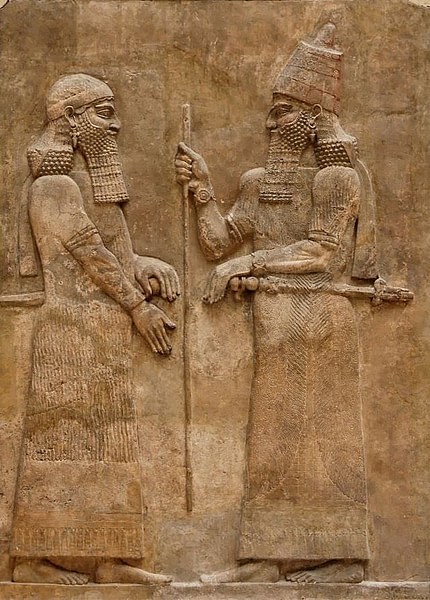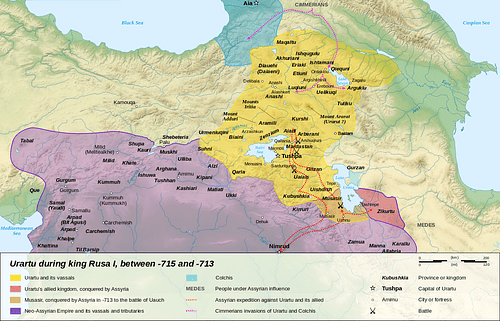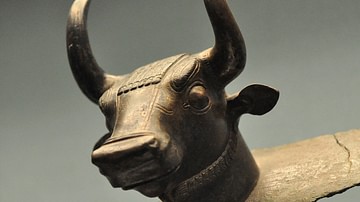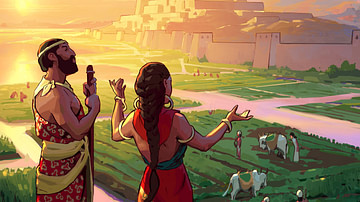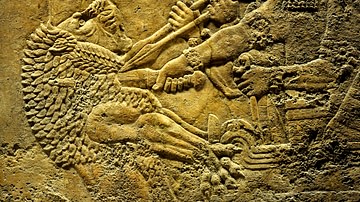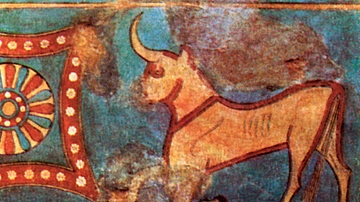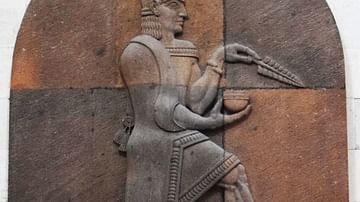It is often when one is faced with the most difficult circumstances that one is given the greatest opportunity for clarity. History provides ample evidence of this experience in showing how, when faced with seemingly impossible situations, people found a way to see beyond a difficult situation and prevail against it.
These stories span centuries and civilizations but all have one thing in common: the heroic nature of the human spirit. Even in the midst of the most daunting circumstances, people can find a way to realize their objectives, sometimes against all odds, and emerge victorious.
One example of this is seen in the 714 BCE Neo-Assyrian campaign of Sargon II (r. 722-705 BCE) against the kingdom of Urartu. While there are plenty of stories that epitomize perseverance and determination, this campaign exemplifies that virtue of the human spirit that helps one endure, and even triumph, when there seems little chance of success.
The Problem of Urartu
Sargon II of Assyria inherited a serious problem when he came to the throne in 722 BCE: the neighboring kingdom of Urartu. Urartu lay in the foothills of the Taurus Mountains, only 30 miles (48 km) from the Assyrian border, and had grown in power throughout the 13th to the 11th centuries BCE. The Temple of Haldi, in the holy city of Mushashir in Urartu, had been an important pilgrimage center since the 3rd millennium BCE, and the offerings from kings, princes, nobility, and merchants filled its treasury.
The Urartians had grown in wealth from trade and from caravans of pilgrims coming to visit Mushashir. To ensure continued prosperity, the Urartians continually tried to keep the lowlands around their kingdom under their control. From their fortress in the mountains, they continually raided and annexed territories in the lowlands. The Urartians were fierce warriors who bred some of the best horses in the region and raised them specifically for combat.
Shalmaneser I (r. 1274-1245 BCE) first mentioned Urartu in Assyrian inscriptions in relating his conquest of the kingdom but, since his time, the Urartians showed themselves resilient and resourceful in that, each time they were beaten, they rose again. Campaigns against them were launched by Sargon II's predecessors Tiglath Pileser III (r. 745-727 BCE) and Shalmaneser V (r. 727-722 BCE) and both had seemed successful, but then the Urartians would return to harass the Assyrian borders and take Assyrian territory.
Early Attempts to Resolve the Problem
In 719 and 717 BCE Sargon II had sent troops against the Urartians at his borders who had invaded and instigated conflict among the Assyrian settlements there. In 715 BCE, Urartu mounted a full-scale invasion and took 22 Assyrian cities along the border. Sargon II retaliated by re-taking the cities, driving the Urartian forces out of Assyrian lands, and razing their southern provinces along the border.
He understood, however, that these kinds of invasions would continue, and he would have to repeatedly expend time and resources in dealing with them. In order to secure his empire against future incursions, Sargon II had to decisively defeat Urartu.
The Urartu Campaign
The difficulty lay in their strategically located kingdom which was nestled in the foothills of the Taurus Mountains and heavily defended. It was for this reason that the previous Assyrian kings who had fought against Urartu had never fully defeated them. The Urartian forces were always able to slip away into the mountains after an engagement, re-group, and then return to harass the empire. Sargon II understood the necessity of conquering Urartu, but the difficulty lay in mounting a frontal assault on the kingdom. Scholar Susan Wise Bauer describes Urartu's defenses:
Sargon's own accounts speak admiringly of the Urartian king Rusas and the network of canals and wells which he built; of the herds of well-bred and guarded horses, raised in protected valleys until they were needed for war; of the splendid efficiency of Urartian communication, with watchtowers built high on mountain peaks, guarding heaps of fuel that could be lit at a moment's notice. One beacon, lit, flared up on its mountaintop into an enormous bonfire that appeared as a spark to the next distant post, where the next bonfire could then be lit. They shone like `stars on mountaintops,' in Sargon's own words, and spread news of invasion faster than a messenger could ride. (376)
The only way to defeat them would be to surprise them and, to that end, Sargon II carefully planned his strategy and then launched his invasion of Urartu in 714 BCE. Leading the army himself, he marched east, skirting the Urartu stronghold, and hoping to bring his forces, unnoticed, up through the flat lands to surprise Urartu from the rear. The Assyrians were a lowland people with no experience in mountain warfare. The previous Assyrian kings who had fought Urartu drove them from the lowlands but never ascended the slopes into the mountains.
Sargon II's forces encountered “looming and unfamiliar slopes covered with thick forests where unknown enemies waited…The cedar forests on the mountain slopes, like those into which Gilgamesh had ventured so many years ago, sheltered an enemy which was more terrifying because it was unseen” (Bauer, 376).
Sargon II, therefore, set the vanguard of his army to clearing a path for his forces to proceed. Sargon II describes this himself in a letter he wrote to his god Ashur, in which he also makes clear the great challenges he faced in his campaign:
Mount Simirria, a great mountain peak that points upwards like the blade of a lance, and raises its head over the mountain where the goddess Belet-ili lives, whose two peaks lean against heaven on high, whose foundations reach into the midst of the netherworld below, which, like the back of a fish, has no road from one side to the other and whose ascent is difficult from front or back, ravines and chasms are deeply cut in its side, and seen from afar, it is shrouded in fear, it is not good to climb in a chariot or with galloping horses, and it is very hard to make infantry progress in it; yet, with the intelligence and wisdom that the gods Ea and Belet-ili destined for me and who broadened my stride to level the enemy land, I made my engineers carry heavy bronze axes, and they smashed the peaks of the high mountain as if it were limestone and made the road smooth. I took the head of my army and made the chariots, cavalry, and battle troops that accompany me fly over it like eagles. I made the support troops and foot solders follow them, and the camels and pack mules jumped over the peaks like goats raised in the mountains. I made the surging flood of Assyrians easily cross over its difficult height and on top of that mountain I set up camp. (Van De Mieroop, 216)
The army had, by this time, been marching through hard terrain in early summer and, though they had been resupplied and watered by previously conquered Medes, they were exhausted by the time they made final camp. Sargon notes the many wide, meandering, streams which ran through the mountains and how they had to forge one of these almost 30 times in the course of their march as it wound back and forth.
Besides the difficulty of the terrain and the constant fear of a surprise attack from all sides, the troops had also had to suffer without their accustomed supply train. In their lowland campaigns, supply routes were easily kept open and spoils were to be taken from conquered regions; this was not so easy in the unfamiliar mountains.
The troops were already unhappy when they were resupplied by the Medes but seem to have become considerably more so by the time they made final camp. Sargon writes how, “their morale turned mutinous. I could give no ease to their weariness, no water to quench their thirst.”
The Pivotal Decision
He selected a battlefield and deployed his troops just as King Rusas arrived with his forces for battle, but Sargon's army would not fight. They had traveled too far and endured too much on the march and now, with the objective before them, they refused to engage the enemy.
At this point, Sargon II was facing the assembled army of Urartu in full formation, and his own troops refused to mobilize and take the field. This moment would certainly constitute a 'dark time' in which Sargon II was faced with a difficult choice. To surrender was unthinkable and to retreat would be to invite disaster, but there seemed no hope of success. Even so, Sargon II had come too far and expended too many resources to simply give up. He called his personal bodyguard around him and then, as Bauer writes:
He led them in a frantic and suicidal attack on the nearest wing of Rusas's force. The wing gave ground in the face of his desperate savagery; and according to his own account, Sargon's army, seeing him fling himself into the line, took courage and followed him in. The Urartian army wavered, broke, and began to retreat. The retreat turned into a rout. The Assyrian army chased the disintegrating enemy westwards, past Lake Urmia and into their own territory. Rusas abandoned any attempt to hold his own capital city, Turushpa, and fled into the mountains. (377)
With Urartu defeated, and fearing that his troops would mutiny if he led them further into the mountains in pursuit, Sargon II turned his forces around and headed back toward Assyria. He paused at the city of Mushashir, however, sacked it, and plundered the holy temple of Haldi, carrying off literally tons of gold, silver, and precious gems.
Conclusion
Sargon II writes that, when King Rusas heard of the sack of Mushashir, “The splendor of Assur overwhelmed him and with his own iron dagger he stabbed himself through the heart, like a pig, and ended his own life.” The Urartians were defeated, and in less than six months of campaign, and so Sargon II returned to his capital of Kalhu at the head of his army in glory, carrying with him the immense wealth of Mushashir.
The difficulty of the Urartu campaign is made clear through Sargon II's letter to Ashur, but the obstacles did not deter the king from pursuing his objective. Even when his men refused to fight, Sargon II would not consider surrender or retreat. He took the risk of personally leading those who would follow him into battle, and he won.
In his letter to his god, Sargon II details the difficulties he had to face in attaining his goal but he never hints at giving up. His perseverance and courage against all odds illustrates the truth of the sentiments expressed in Walter D. Wintle's poem, Thinking (from which the famous quote attributed to Henry Ford may have originated – even though Ford may never have actually said it): “If you think you can – or think you can't – you're right.”
Sargon II's resolve provides an example worth following for those in the present day who, faced with their own dark times, can still choose to fight against the forces which threaten them – and prevail.
